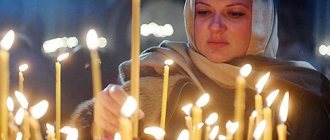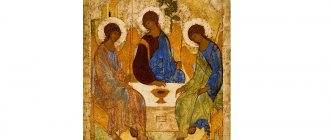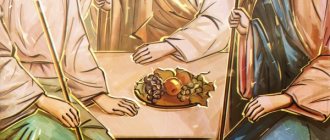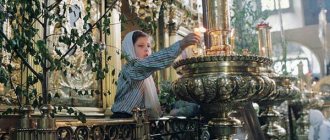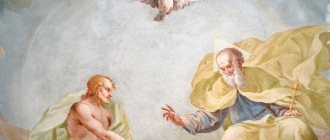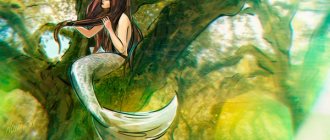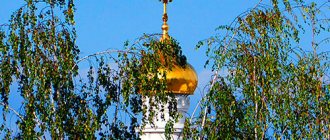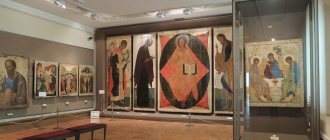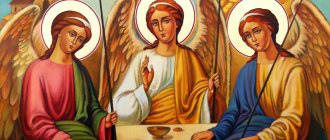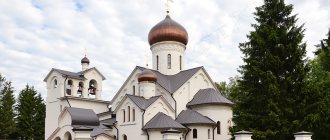The main dogma of Christianity is the doctrine of three persons of one essentially God, who are the Holy Trinity. These three hypostases contained in Him - God the Father, God the Son and God the Holy Spirit are not merged with each other and are inseparable. Each of them is a manifestation of one of its essences. The Holy Church teaches about the complete unity of the Trinity, which creates the world, provides for it and sanctifies it.
Image of the Holy Trinity in icon painting
The Holy Trinity is a traditional subject of Orthodox icon painting. But since a direct depiction of God would be a violation of the concept of his eternity and incomprehensibility, expressed in the words of the Evangelist John: “No one has ever seen God,” it is customary to use his symbolic images, the main of which is the Old Testament Trinity.
To reveal this image, icon painters traditionally resort to depicting the scene described in chapter 18 of the biblical Book of Genesis. It was called "Hospitality of Abraham."
Verses 1 to 18 tell how the forefather Abraham, during his day's rest, was honored with a visit from three men.
Having seen with his spiritual eyes that God himself appeared before him in their image, Abraham showed the greatest respect and hospitality to those who came.
It was this scene that became the basis of the traditional iconographic plot - the Trinity of the Old Testament.
As mentioned above, deprived of the opportunity to directly depict the Creator of the world, the masters resorted to symbolism in their works, which became their main expressive technique.
Thus, it became a tradition, secured by the blessing of the church hierarchs, to represent the men who visited Abraham in the form of three angels.
The appearance of the Holy Trinity in picturesque scenes
For the first time, images depicting the Old Testament Trinity appeared in the 2nd century on the walls of the Roman catacombs, where the first Christians performed divine services in secret from the pagan authorities.
These drawings did not yet correspond to the canons established in later centuries, and the scenes presented in them looked quite historical.
But already during this period, artists unknown to us tried to emphasize the identity of all three of Abraham’s guests.
Later, the term “isokephaly” appeared in theology, which denoted the equality of travelers. In the wall images of the Roman catacombs, it is emphasized by the deliberate similarity of the poses and clothes of the three husbands. Gradually, the depiction of the guests who visited the Old Testament forefather began to take on an increasingly symbolic character, and over time, a tradition developed of depicting them in angelic form.
It is important to note that the plot of the “Trinity of the Old Testament” is often presented in two versions - isokephal and non-isokephal. In the first case, as is clear from the term itself, while the composition is completely static, the mutual equality of the three angels is emphasized. In the second, one of them is highlighted with a halo, an image of a cross or a corresponding inscription.
Mosaic of an ancient basilica
Besides the Holy Trinity, one of the oldest images of Her on the walls of the catacombs is the 5th century mosaic on the Triumphal Arch of the Roman Basilica of Santa Maria Maggiore. The composition of the image is quite complex. It is visually divided into two parts.
The top one depicts Abraham running out to meet the wanderers, one of whom is surrounded by a shining halo - a symbol of holiness, and the bottom one shows a set table at which the guests are sitting. The owner of the house Abraham is depicted twice in it - serving guests and giving instructions to his wife Sarah.
The background is the view of a rich building with a tower - apparently the house of Abraham and the Mamre oak, under which the meeting took place.
The final version of the composition
In the 14th century, the composition of icons depicting the Holy Trinity took shape in the form in which its most famous examples were painted.
This is evidenced by the icon of the “Zyryan Trinity”, created during this period and attributed to the brush of St. Stephen of Perm.
It is generally accepted that it was in it that a scene was first presented, the center of the composition of which is angels sitting at a laid table.
Andrey Rublev: “The Trinity of the Old Testament”
A lot has been written and said about this work. And this is no coincidence, because among the variety of icons painted on the plot of “The Hospitality of Abraham,” Rublev’s “Old Testament Trinity” occupies a special place.
According to the unanimous opinion of art historians and all connoisseurs of ancient Russian painting, in it the artist achieved the highest degree of revelation of the spiritual essence of the Triune Deity.
This work, created in the 15th century, became one of the most famous Russian icons.
The compositional solution of the image is very original. The figures of angels seem to be inscribed in an invisible circle, symbolizing the consubstantiality of all three hypostases.
At the same time, the artist achieves an effect in which the viewer’s gaze does not linger on any of them, but freely resides within the space formed by them, the semantic center of which is the bowl with the head of a sacrificial lamb. It is around her that a silent dialogue of gestures takes place.
Christian symbolism in Rublev’s icon
It follows about - an icon full of symbolic attributes expressing the basic Christian dogmas. It is no coincidence that the background for depicting the figures of angels is a house, a tree and a mountain.
Their images are full of concrete meaning. So, the angel on the left symbolizes God the Father.
This is evidenced by the image of the house placed above Him - the chambers of Abraham, which corresponds to the initial moment of the Divine economy, carried out according to his will.
The tree - the oak of Mamre, depicted above the central figure, is involuntarily reinterpreted as the tree of life, and is associated with the sufferings of the Savior on the cross. Accordingly, the viewer has no doubt that the author depicted the Son of God Jesus Christ as the central figure of the composition.
As for the figure of the left angel, a hint of its identity is the mountain depicted above it - a symbol of spiritual ascent carried out through the action of the third hypostasis of the Holy Spirit. The most significant events are associated with the image of a mountain in the Bible. These are the giving of the tablets of the Covenant on Sinai, the Transfiguration of the Lord on Tabor and the Ascension on Mount Elion in Jerusalem.
It should be noted that there is another important idea expressed by the “Trinity of the Old Testament.” Andrei Rublev, in his truly brilliant creation, managed to create a prototype of true unity and love.
His figures, devoid of active movement, and as if immersed in motionless contemplation, are full of silent communication.
Before the viewer’s eyes appears the process of communication of divine energy contained within the three hypostases of God.
Mosaic of an ancient basilica
Besides the Holy Trinity, one of the oldest images of Her on the walls of the catacombs is the 5th century mosaic on the Triumphal Arch of the Roman Basilica of Santa Maria Maggiore. The composition of the image is quite complex. It is visually divided into two parts. The top one depicts Abraham running out to meet the wanderers, one of whom is surrounded by a shining halo - a symbol of holiness, and the bottom one shows a set table at which the guests are sitting. The owner of the house Abraham is depicted twice in it - serving guests and giving instructions to his wife Sarah. The background is the view of a rich building with a tower - apparently the house of Abraham and the Mamre oak, under which the meeting took place.
Icon - New Testament Trinity. In the icon case
Icon - New Testament Trinity. In the icon case- New
Testament icon of the Holy Trinity. - And the image of God the Father in the form of a gray-haired old man, the Son in the form of a husband sitting on a throne at His right hand; The Holy Spirit in the form of a dove above the throne.
- The Dogma of the Holy Trinity is the foundation of the Christian religion
- God is one in essence, but trinity in persons: Father, Son and Holy Spirit, the Trinity is consubstantial and indivisible.
The word “Trinity” itself, of non-biblical origin, was introduced into the Christian lexicon in the second half of the 2nd century by St. Theophilus of Antioch. The doctrine of the Holy Trinity is given in Christian Revelation.
The dogma of the Holy Trinity is incomprehensible, it is a mysterious dogma, incomprehensible at the level of reason. For the human mind, the doctrine of the Holy Trinity is contradictory, because it is a mystery that cannot be expressed rationally.
It is no coincidence that Fr. Pavel Florensky called the dogma of the Holy Trinity “a cross for human thought.” In order to accept the dogma of the Most Holy Trinity, the sinful human mind must reject its claims to the ability to know everything and rationally explain, that is, in order to understand the mystery of the Most Holy Trinity, it is necessary to reject its understanding.
The mystery of the Most Holy Trinity is comprehended, and only partially, in the experience of spiritual life. This comprehension is always associated with ascetic feat. V.N. Lossky says: “The apophatic ascent is an ascent to Golgotha, therefore no speculative philosophy could ever rise to the mystery of the Holy Trinity.”
Belief in the Trinity distinguishes Christianity from all other monotheistic religions: Judaism, Islam.
The doctrine of the Trinity is the basis of all Christian faith and moral teaching, for example, the doctrine of God the Savior, God the Sanctifier, etc. V.N.
Lossky said that the Doctrine of the Trinity “is not only the basis, but also the highest goal of theology, for... to know the mystery of the Most Holy Trinity in its fullness means to enter into Divine life, into the very life of the Most Holy Trinity.”
- The doctrine of the Triune God comes down to three points:
- 1) God is trinity and trinity consists in the fact that in God there are Three Persons (hypostases): Father, Son, Holy Spirit.
- 2) Each Person of the Holy Trinity is God, but They are not three Gods, but are one Divine being.
- 3) All three Persons differ in personal or hypostatic properties.
Icon of Simon Ushakov
Another widely known icon is the “Old Testament Trinity”, the author of which is the master of the Silver Chamber at the Armory Order of the Moscow Kremlin, Simon Ushakov. It was written in 1667. In its composition, Ushakov’s “Old Testament Trinity” follows the tradition of Andrei Rublev. It presents the same scene of the appearance of wanderers to the forefather Abraham, and also the figures of angels are inscribed in a circle, giving the viewer the impression of a certain unity. However, this work has its own individual characteristics.
Icon of the Holy Trinity
In front of the image of the Holy Trinity, they pray to God for all their needs and, of course, confess their sins and prayerfully prepare for Confession and Communion. The Church blesses us to read the morning and evening prayers every day, which are in every prayer book, with conversions and repentance before the Lord. Any prayers can be read both in the temple and in front of the home iconostasis.
Let us remember that the Church blesses us to read morning and evening prayers every day, turning to the Lord and the Heavenly Powers. Pray to the Lord Almighty at any moment in life in all your needs:
- Ask the Lord for help in any matter, everyday difficulties and troubles,
- Ask for help with the needs of your loved ones and friends,
- Repent before God of your sins, asking to forgive them, to let you see your mistakes and vices and correct yourself,
- Praying for healing in illness,
- Turning to Him in sudden danger,
- When you have anxiety, despondency, sadness in your soul,
- Thank Him for your joys, successes, happiness and health.
In Orthodoxy there is a separate holiday - the Day of the Holy Trinity, which is celebrated on the 50th day after Easter, in memory of the Descent of the Holy Spirit on the Apostles.
On this day, prayers are read to the Most Holy Trinity and separately to the Holy Spirit, which should also be read daily in order to be protected from evil with the help of God.
Prayer “Trisagion”: Holy God, Holy Mighty, Holy Immortal, have mercy on us! - you need to read three times, crossing yourself and bowing. Glory to the Father, and the Son, and the Holy Spirit, now, and always, and forever. Amen.
Heavenly King, Comforter, Spirit of Truth, Who is present everywhere and does everything, Treasure of kindness and giver of life, come and dwell in us, and cleanse us from all impurity, and save, O Good One, our souls.
Most Holy Trinity, have mercy on us: Lord, cleanse our sins, Master, forgive our iniquities, Holy One, visit and heal our illnesses for the sake of our confession of Your Name. Amen.
The Lord's Prayer, simply, is the “Our Father,” the words of which all our ancestors knew (there was even the expression “to know like the Lord’s Prayer”) and which every believer should teach his children. If you don’t know its words, learn them by heart; you can read the Lord’s Prayer in Russian:
“Our Father who is in Heaven! May your name be holy and glorified, may your kingdom come, may your will be done, both in heaven and on earth.
Give us the bread we need today; and forgive us our debts, which we forgive our debtors; and may we not have the temptations of the devil, but deliver us from the influences of the evil one.
For Yours is in heaven and earth the Kingdom and the power and the glory of the Father, and the Son, and the Holy Spirit forever. Amen".
Source: https://www.o-vere.ru/ikona-svjatoj-troici.html
Decoration replacing symbolism
It is easy to notice that Ushakov’s angels, although close in their design to the figures depicted on the icon of Andrei Rublev, differ from them in their excessive physicality and naturalness. Their wings, painted with careful detail, seem heavy and are not capable of lifting even ethereal spirits into the air.
The background against which the entire scene is presented is also strikingly different. If for Rublev it has, first of all, a symbolic meaning, then for Ushakov it is rather decorative. It's just a beautiful landscape with an old palazzo, a mountain and a picturesque tree. In the “Old Testament Trinity” icon, this author practically deprived all three landscape attributes of their symbolic meaning. Even a quick glance at them is enough to recall similar details in Veronese’s paintings.
The table decoration also attracts attention. If in Rublev it is limited to only one bowl with the head of a calf, which is also full of symbolic meaning and directs the viewer’s thoughts to reflect on the atoning sacrifice of the Son of God, then in this case the painter emphasized the rich table setting, combined with the exquisite painting of the chairs. Such an abundance of decorativeness is not typical for an icon.
Disputes about the possibility of depicting God the Father
There are other iconographic versions of the New Testament Trinity, such as “The Crucifixion in the Bosom of the Father,” “The Eternal Light,” “The Sending of Christ to Earth” and a number of others. However, despite their widespread use, debates about the legality of depicting such subjects have not subsided among theologians for centuries.
Skeptics appeal to the fact that, according to the Gospel, no one has ever seen God the Father, and therefore it is impossible to depict him. In support of their opinion, they mention the Great Moscow Council of 1666-1667, the 43rd paragraph of which prohibits the image of God the Father, which at one time gave reason for the removal of many icons from use.
Their opponents also base their statements on the Gospel, citing the words of Christ: “He who has seen Me has seen My Father.” One way or another, the New Testament Trinity, despite the controversy, is firmly included in the subjects of icons revered by the Orthodox Church. By the way, all of the listed versions of the New Testament Trinity appeared in Russian art relatively late. Until the 16th century they were unknown.
Why is the doctrine of the Trinity so important to Christians?
To put it quite simply, because it serves as the basis of the Christian view of the world, of what is the driving force and meaning of our lives.
From the Gospel we know: God is love (1 John 4 :8). Love is not just one of the characteristics of God, not just His relationship to created beings, but a key principle of Divine existence. God is love always, He was love even before He created the world, and He will remain love after the earth and all the works on it are burned up (2 Pet 3:10 ). The existence of the world is not a necessary condition for God to be love. He is love already in Himself.
But in love there are always at least two parties who love each other. And, if God really is love, He cannot be a Person closed in Himself, as, for example, the famous philosopher and scientist Gottfried Leibniz believed. He must be at least a Two.
We are familiar and understand the situation when two people love each other. But the Holy Scripture says something much less understandable about God: He is the Trinity and He is love.
Perhaps it will be a little easier for us to understand this if we look at a family in which there is a father, mother and child. Mother and father love each other, but do not completely isolate themselves on each other, but generously share this love with the third child (or with children, if there are several of them).
It happens that a married couple does not have children, but even then their love can be poured out on someone else, be it an adopted child, elderly parents, or even some stranger in need of help (this is how they lived, giving themselves to those in need, for example, the childless Grand Duke Sergei Alexandrovich Romanov and his wife Elizaveta Feodorovna).
Of course, relationships between people cannot be directly projected onto Divine reality. And yet, the example of the family shows that true love cannot have a “third wheel.”
“Trinity implies equality of rights for more than two, it makes love perfect,” emphasizes Archpriest Maxim Kozlov, professor at the Moscow Theological Academy.
“Perfect love is the paradoxical unity of two facts: on the one hand, the existence of several “I”s that love each other while remaining separate, and, on the other hand, the highest degree of unity between Them,” wrote the famous Romanian theologian Archpriest Dumitru Staniloe in the 20th century . - There can be no other justification for love in the world, no other purpose for the existence of the world, other than the existence of perfect eternal love. Love in the world presupposes as its source and goal eternal perfect love between several Divine Persons.”
Of course, we will never be able to exhaustively explain why God is threefold: the human mind cannot comprehend the mystery of Divine existence. Theologians are just trying to describe the relationship of the three Hypostases with the words that are at their disposal, and to understand what follows from this for the Church and for every Christian.
Trinity of the New Testament
The plot of the icons described above is taken from the Old Testament, which is why they are called “Old Testament Trinity”. But one cannot ignore the frequently encountered images of the New Testament Trinity - another version of the image of the Divine Trinity. It is based on the words of Jesus Christ quoted in the Gospel of John: “I and the Father are one.” In this plot, the three Divine hypostases are represented by images of God the Father in the form of a gray-haired old man, God the Son, that is, Christ, in the form of a middle-aged man, and the Holy Spirit in the form of a Dove.
